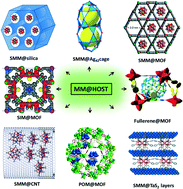当前位置:
X-MOL 学术
›
CrystEngComm
›
论文详情
Our official English website, www.x-mol.net, welcomes your feedback! (Note: you will need to create a separate account there.)
Porous substrates as platforms for the nanostructuring of molecular magnets
CrystEngComm ( IF 3.1 ) Pub Date : 2017-12-20 00:00:00 , DOI: 10.1039/c7ce01978e Darpandeep Aulakh 1, 2, 3, 4 , Hubert K. Bilan 1, 2, 3, 4 , Mario Wriedt 1, 2, 3, 4
CrystEngComm ( IF 3.1 ) Pub Date : 2017-12-20 00:00:00 , DOI: 10.1039/c7ce01978e Darpandeep Aulakh 1, 2, 3, 4 , Hubert K. Bilan 1, 2, 3, 4 , Mario Wriedt 1, 2, 3, 4
Affiliation

|
Single molecule magnets (SMMs) and single ion magnets (SIMs), also known as molecular magnets (MMs), exhibit magnetic bistability and slow relaxation of their magnetization, characteristics which are representative of nanodomain particles whose origin is attributed to individual molecular spins. MMs have been receiving significant attention due to their potential applications in (1) ultra-high-density information storage devices, where each molecule can be used as a magnetic bit of information, and (2) quantum computing applications, taking advantage of lengthy coherence intervals. Any practical applications of MMs however, requires their controlled organization in different dimensionality architectures to allow for read-and-write processes, which is a challenge given that their chemical integrity and unique magnetic properties must be preserved during the nanostructuration process. This feature article highlights recent advances in this newly emerging field on the nanostructuration of MMs, and provides a comprehensive review of MM composites derived from various porous substrates, with particular emphases on synthetic approaches and characterization strategies.
中文翻译:

多孔基质作为分子磁体纳米结构的平台
单分子磁体(SMM)和单离子磁体(SIM),也称为分子磁体(MM),具有磁双稳性和磁化缓慢缓和的特性,代表了纳米域粒子的代表,其起源可归因于单个分子的自旋。MM由于其在(1)超高密度信息存储设备中的潜在应用而受到了广泛关注,在超高密度信息存储设备中,每个分子都可以用作信息的磁性位;以及(2)利用长相干性的量子计算应用间隔。但是,MM的任何实际应用都需要它们在不同维度架构中的受控组织,以允许读写过程,鉴于在纳米结构化过程中必须保留其化学完整性和独特的磁性,这是一个挑战。这篇专题文章重点介绍了MM纳米结构这一新兴领域的最新进展,并对来自各种多孔基材的MM复合材料进行了全面综述,其中特别强调了合成方法和表征策略。
更新日期:2017-12-20
中文翻译:

多孔基质作为分子磁体纳米结构的平台
单分子磁体(SMM)和单离子磁体(SIM),也称为分子磁体(MM),具有磁双稳性和磁化缓慢缓和的特性,代表了纳米域粒子的代表,其起源可归因于单个分子的自旋。MM由于其在(1)超高密度信息存储设备中的潜在应用而受到了广泛关注,在超高密度信息存储设备中,每个分子都可以用作信息的磁性位;以及(2)利用长相干性的量子计算应用间隔。但是,MM的任何实际应用都需要它们在不同维度架构中的受控组织,以允许读写过程,鉴于在纳米结构化过程中必须保留其化学完整性和独特的磁性,这是一个挑战。这篇专题文章重点介绍了MM纳米结构这一新兴领域的最新进展,并对来自各种多孔基材的MM复合材料进行了全面综述,其中特别强调了合成方法和表征策略。


























 京公网安备 11010802027423号
京公网安备 11010802027423号